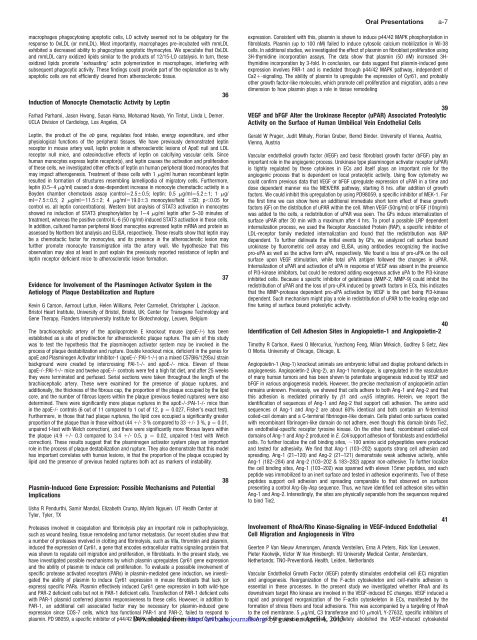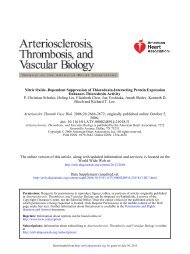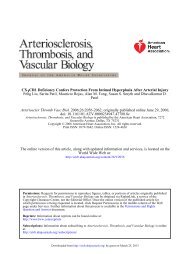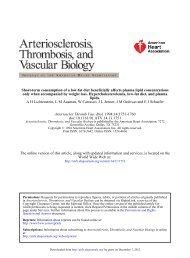Oral Presentations - Arteriosclerosis, Thrombosis, and Vascular ...
Oral Presentations - Arteriosclerosis, Thrombosis, and Vascular ...
Oral Presentations - Arteriosclerosis, Thrombosis, and Vascular ...
Create successful ePaper yourself
Turn your PDF publications into a flip-book with our unique Google optimized e-Paper software.
macrophages phagocytosing apoptotic cells, LO activity seemed not to be obligatory for the<br />
response to OxLDL (or mmLDL). Most importantly, macrophages pre-incubated with mmLDL<br />
exhibited a decreased ability to phagocytose apoptotic thymocytes. We speculate that OxLDL<br />
<strong>and</strong> mmLDL carry oxidized lipids similar to the products of 12/15-LO catalysis. In turn, these<br />
oxidized lipids promote exhausting actin polymerization in macrophages, interfering with<br />
subsequent phagocytic activity. These findings could provide part of the explanation as to why<br />
apoptotic cells are not efficiently cleared from atherosclerotic tissue.<br />
Induction of Monocyte Chemotactic Activity by Leptin<br />
Farhad Parhami, Jason Hwang, Susan Hama, Mohamad Navab, Yin Tintut, Linda L Demer.<br />
UCLA Division of Cardiology, Los Angeles, CA<br />
Leptin, the product of the ob gene, regulates food intake, energy expenditure, <strong>and</strong> other<br />
physiological functions of the peripheral tissues. We have previously demonstrated leptin<br />
receptor in mouse artery wall, leptin protein in atherosclerotic lesions of ApoE null <strong>and</strong> LDL<br />
receptor null mice, <strong>and</strong> osteoinductive effects of leptin on calcifying vascular cells. Since<br />
human monocytes express leptin receptor(s), <strong>and</strong> leptin causes the activation <strong>and</strong> proliferation<br />
of these cells, we investigated other effects of leptin on human peripheral blood monocytes that<br />
may impact atherogenesis. Treatment of these cells with 1 g/ml human recombinant leptin<br />
resulted in formation of structures resembling lamellipodia of migratory cells. Furthermore,<br />
leptin (0.5–4 g/ml) caused a dose-dependent increase in monocyte chemotactic activity in a<br />
Boyden chamber chemotaxis assay (control2.50.5; leptin: 0.5 g/ml5.21; 1 g/<br />
ml7.50.5; 2 g/ml11.52; 4 g/ml19.03 monocytes/field SD; p0.05 for<br />
control vs. all leptin concentrations). Western blot anaylsis of STAT3 activation in monocytes<br />
showed no induction of STAT3 phosphorylation by 1–4 g/ml leptin after 5–30 minutes of<br />
treatment, whereas the positive control IL-6 (50 ng/ml) induced STAT3 activation in those cells.<br />
In addition, cultured human peripheral blood monocytes expressed leptin mRNA <strong>and</strong> protein as<br />
assessed by Northern blot analysis <strong>and</strong> ELISA, respectively. These results show that leptin may<br />
be a chemotactic factor for monocytes, <strong>and</strong> its presence in the atherosclerotic lesion may<br />
further promote monocyte transmigration into the artery wall. We hypothesize that this<br />
observation may also at least in part explain the previously reported resistance of leptin <strong>and</strong><br />
leptin receptor deficient mice to atherosclerotic lesion formation.<br />
Evidence for Involvement of the Plasminogen Activator System in the<br />
Aetiology of Plaque Destabilization <strong>and</strong> Rupture<br />
Kevin G Carson, Aernout Luttun, Helen Williams, Peter Carmeliet, Christopher L Jackson.<br />
Bristol Heart Institute, University of Bristol, Bristol, UK; Center for Transgene Technology <strong>and</strong><br />
Gene Therapy, Fl<strong>and</strong>ers Interuniversity Institute for Biotechnology, Leuven, Belgium<br />
The brachiocephalic artery of the apolipoprotein E knockout mouse (apoE-/-) has been<br />
established as a site of predilection for atherosclerotic plaque rupture. The aim of this study<br />
was to test the hypothesis that the plasminogen activator system may be involved in the<br />
process of plaque destabilization <strong>and</strong> rupture. Double knockout mice, deficient in the genes for<br />
apoE <strong>and</strong> Plasminogen Activator Inhibitor-1 (apoE-/-:PAI-1-/-) on a mixed C57Bl6/129SvJ strain<br />
background were created by intercrossing PAI-1-/- <strong>and</strong> apoE-/- mice. Eleven of these<br />
apoE-/-:PAI-1-/- mice <strong>and</strong> twelve apoE-/- controls were fed a high fat diet, <strong>and</strong> after 25 weeks<br />
they were terminated <strong>and</strong> perfused. Serial sections were taken throughout the length of the<br />
brachiocephalic artery. These were examined for the presence of plaque ruptures, <strong>and</strong><br />
additionally, the thickness of the fibrous cap, the proportion of the plaque occupied by the lipid<br />
core, <strong>and</strong> the number of fibrous layers within the plaque (previous healed ruptures) were also<br />
determined. There were significantly more plaque ruptures in the apoE-/-:PAI-1-/- mice than<br />
in the apoE-/- controls (6 out of 11 compared to 1 out of 12, p 0.027, Fisher’s exact test).<br />
Furthermore, in those that had plaque ruptures, the lipid core occupied a significantly greater<br />
proportion of the plaque than in those without (44 /- 3 % compared to 33 /-3%,p 0.01,<br />
unpaired t-test with Welch correction), <strong>and</strong> there were significantly more fibrous layers within<br />
the plaque (4.9 /- 0.3 compared to 3.4 /- 0.5, p 0.02, unpaired t-test with Welch<br />
correction). These results suggest that the plasminogen activator system plays an important<br />
role in the process of plaque destabilization <strong>and</strong> rupture. They also demonstrate that this model<br />
has important correlates with human lesions, in that the proportion of the plaque occupied by<br />
lipid <strong>and</strong> the presence of previous healed ruptures both act as markers of instability.<br />
Plasmin-Induced Gene Expression: Possible Mechanisms <strong>and</strong> Potential<br />
Implications<br />
Usha R Pendurthi, Samir M<strong>and</strong>al, Elizabeth Crump, Mylinh Ngyuen. UT Health Center at<br />
Tyler, Tyler, TX<br />
Proteases involved in coagulation <strong>and</strong> fibrinolysis play an important role in pathophysiology,<br />
such as wound healing, tissue remodeling <strong>and</strong> tumor metastasis. Our recent studies show that<br />
a number of proteases involved in clotting <strong>and</strong> fibrinolysis, such as VIIa, thrombin <strong>and</strong> plasmin,<br />
induced the expression of Cyr61, a gene that encodes extracellular matrix signaling protein that<br />
was shown to regulate cell migration <strong>and</strong> proliferation, in fibroblasts. In the present study, we<br />
have investigated possible mechanisms by which plasmin upregulates Cyr61 gene expression<br />
<strong>and</strong> the ability of plasmin to induce cell proliferation. To evaluate a posssible involvement of<br />
specific protease activated receptors (PARs) in plasmin-mediated gene induction, we investigated<br />
the ability of plasmin to induce Cyr61 expression in mouse fibroblasts that lack (or<br />
express) specific PARs. Plasmin effectively induced Cyr61 gene expression in both wild-type<br />
<strong>and</strong> PAR-2 deficient cells but not in PAR-1 deficient cells. Transfection of PAR-1 deficient cells<br />
with PAR-1 plasmid conferred plasmin responsiveness to these cells. However, in addition to<br />
PAR-1, an additional cell associated factor may be necessary for plasmin-induced gene<br />
expression since COS-7 cells, which has functional PAR-1 <strong>and</strong> PAR-2, failed to respond to<br />
plasmin. PD 98059, a specific inhibitor of p44/42 Downloaded MAPK, inhibited plasmin-induced from<br />
Cyr61 gene<br />
36<br />
37<br />
38<br />
http://atvb.ahajournals.org/<br />
<strong>Oral</strong> <strong>Presentations</strong> a-7<br />
expression. Consistent with this, plasmin is shown to induce p44/42 MAPK phosphorylation in<br />
fibroblasts. Plasmin (up to 100 nM) failed to induce cytosolic calcium mobilization in WI-38<br />
cells. In additional studies, we investigated the effect of plasmin on fibroblast proliferation using<br />
3H-thymidine incorporation assays. The data show that plasmin (50 nM) increased 3Hthymidine<br />
incorporation by 3-fold. In conclusion, our data suggest that plasmin-induced gene<br />
expression involves PAR-1 <strong>and</strong> is mediated through p44/42 MAPK pathway, independent of<br />
Ca2-signaling. The ability of plasmin to upregulate the expression of Cyr61, <strong>and</strong> probably<br />
other growth factor-like molecules, which promote cell proliferation <strong>and</strong> migration, adds a new<br />
dimension to how plasmin plays a role in tissue remodeling<br />
39<br />
VEGF <strong>and</strong> bFGF Alter the Urokinase Receptor (uPAR) Associated Proteolytic<br />
Activity on the Surface of Human Umbilical Vein Endothelial Cells<br />
Gerald W Prager, Judit Mihaly, Florian Gruber, Bernd Binder. University of Vienna, Austria,<br />
Vienna, Austria<br />
<strong>Vascular</strong> endothelial growth factor (VEGF) <strong>and</strong> basic fibroblast growth factor (bFGF) play an<br />
important role in the angiogenic process. Urokinase type plasminogen activator receptor (uPAR)<br />
is tightly regulated by these cytokines in ECs <strong>and</strong> itself plays an important role for the<br />
angiogenic process that is dependent on local proteolytic activity. Using flow cytometry we<br />
could confirm previous data that VEGF or bFGF upregulate expression of uPAR in a time <strong>and</strong><br />
dose dependent manner via the MEK/ERK pathway, starting 8 hrs. after addition of growth<br />
factors. We could inhibit this upregulation by using PD98059, a specific inhibitor of MEK-1. For<br />
the first time we can show here an additional immediate short term effect of these growth<br />
factors (GF) on the distribution of uPAR within the cell. When VEGF (50ng/ml) or bFGF (10ng/ml)<br />
was added to the cells, a redistribution of uPAR was seen. The GFs induce internalization of<br />
surface uPAR after 30 min with a maximum after 4 hrs. To proof a possible LRP dependent<br />
internalization process, we used the Receptor Associated Protein (RAP), a specific inhibitor of<br />
LDL-receptor family mediated internalization <strong>and</strong> found that the redistribution was RAP<br />
dependent. To further delineate the initial events by GFs, we analyzed cell surface bound<br />
urokinase by fluorometric cell assay <strong>and</strong> ELISA, using antibodies recognizing the inactive<br />
pro-uPA as well as the active form uPA, respectively. We found a loss of pro-uPA on the cell<br />
surface upon VEGF stimulation, while total uPA antigen followed the changes in uPAR.<br />
Internalization of uPAR <strong>and</strong> activation of uPA in response of VEGF was absent in the presence<br />
of PI3-kinase inhibitors, but could be restored adding exogenous active uPA to the PI3-kinase<br />
inhibited cells. Because a specific inhibitor of gelatinases (MMP-2, MMP-9) could inhibit the<br />
redistribution of uPAR <strong>and</strong> the loss of pro-uPA induced by growth factors in ECs, this indicates<br />
that the MMP-protease dependent pro-uPA activation by VEGF is the part being PI3-kinase<br />
dependent. Such mechanism might play a role in redistribution of uPAR to the leading edge <strong>and</strong><br />
fine tuning of surface bound proteolytic activity.<br />
40<br />
Identification of Cell Adhesion Sites in Angiopoietin-1 <strong>and</strong> Angiopoietin-2<br />
Timothy R Carlson, Kwesi O Mercurius, Yuezhong Feng, Milan Mrksich, Godfrey S Getz, Alex<br />
O Morla. University of Chicago, Chicago, IL<br />
Angiopoietin-1 (Ang-1) knockout animals are embryonic lethal <strong>and</strong> display profound defects in<br />
angiogenesis. Angiopoietin-2 (Ang-2), an Ang-1 homologue, is upregulated in the vasculature<br />
of many human tumors <strong>and</strong> has been shown to potentiate angiogenesis induced by VEGF <strong>and</strong><br />
bFGF in various angiogenesis models. However, the precise mechanism of angiopoietin action<br />
remains unknown. Previously, we showed that cells adhere to both Ang-1 <strong>and</strong> Ang-2 <strong>and</strong> that<br />
this adhesion is mediated primarily by 1 <strong>and</strong> v5 integrins. Herein, we report the<br />
identification of sequences of Ang-1 <strong>and</strong> Ang-2 that support cell adhesion. The amino acid<br />
sequences of Ang-1 <strong>and</strong> Ang-2 are about 60% identical <strong>and</strong> both contain an N-terminal<br />
coiled-coil domain <strong>and</strong> a C-terminal fibrinogen-like domain. Cells plated onto surfaces coated<br />
with recombinant fibrinogen-like domain do not adhere, even though this domain binds Tie2,<br />
an endothelial-specific receptor tyrosine kinase. On the other h<strong>and</strong>, recombinant coiled-coil<br />
domains of Ang-1 <strong>and</strong> Ang-2 produced in E. Coli support adhesion of fibroblasts <strong>and</strong> endothelial<br />
cells. To further localize the cell binding sites, 100 amino acid polypeptides were produced<br />
<strong>and</strong> tested for adhesivity. We find that Ang-1 (103–202) supports strong cell adhesion <strong>and</strong><br />
spreading. Ang-1 (21–120) <strong>and</strong> Ang-2 (21–121) demonstrate weak adhesive activity, while<br />
Ang-1 (182–284) <strong>and</strong> Ang-2 (103–202 & 183–282) appear non-adhesive. To further localize<br />
the cell binding sites, Ang-1 (103–202) was spanned with eleven 15mer peptides, <strong>and</strong> each<br />
peptide was immobilized to an inert surface <strong>and</strong> tested in adhesion experiments. Two of these<br />
peptides support cell adhesion <strong>and</strong> spreading comparable to that observed on surfaces<br />
presenting a control Arg-Gly-Asp sequence. Thus, we have identified cell adhesion sites within<br />
Ang-1 <strong>and</strong> Ang-2. Interestingly, the sites are physically separable from the sequences required<br />
to bind Tie2.<br />
Involvement of RhoA/Rho Kinase-Signaling in VEGF-Induced Endothelial<br />
Cell Migration <strong>and</strong> Angiogenesis in Vitro<br />
Geerten P Van Nieuw Amerongen, Am<strong>and</strong>a Versteilen, Erna A Peters, Rick Van Leeuwen,<br />
Pieter Koolwijk, Victor W Van Hinsbergh. VU University Medical Center, Amsterdam,<br />
Netherl<strong>and</strong>s; TNO-Prevention& Health, Leiden, Netherl<strong>and</strong>s<br />
<strong>Vascular</strong> Endothelial Growth Factor (VEGF) potently stimulates endothelial cell (EC) migration<br />
<strong>and</strong> angiogenesis. Reorganization of the F-actin cytoskeleton <strong>and</strong> cell-matrix adhesion is<br />
essential in these processes. In the present study we investigated whether RhoA <strong>and</strong> its<br />
downstream target Rho kinase are involved in the VEGF-induced EC changes. VEGF induced a<br />
rapid <strong>and</strong> prolonged reorganization of the F-actin cytoskeleton in ECs, manifested by the<br />
formation of stress fibers <strong>and</strong> focal adhesions. This was accompanied by a targeting of RhoA<br />
to the cell membrane. 5 g/mL C3 transferase <strong>and</strong> 10 mol/L Y-27632, specific inhibitors of<br />
RhoA <strong>and</strong>by Rho guest kinaseon respectively, April 4, 2013 completely abolished the VEGF-induced cytoskeletal<br />
41














